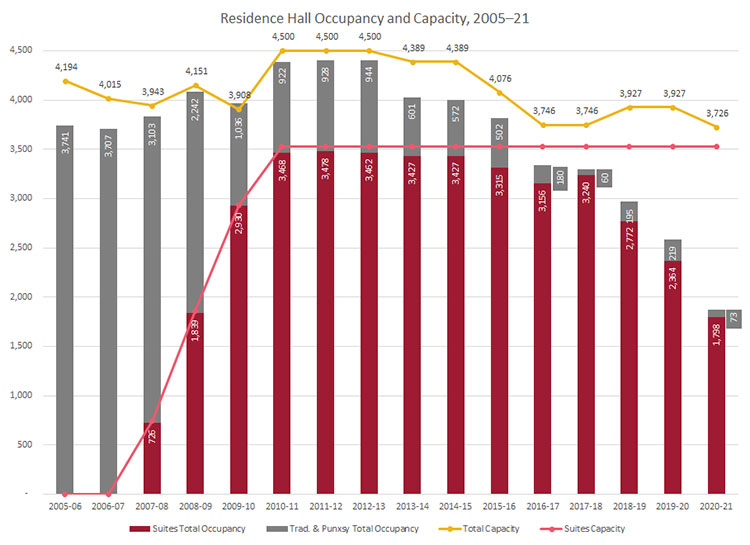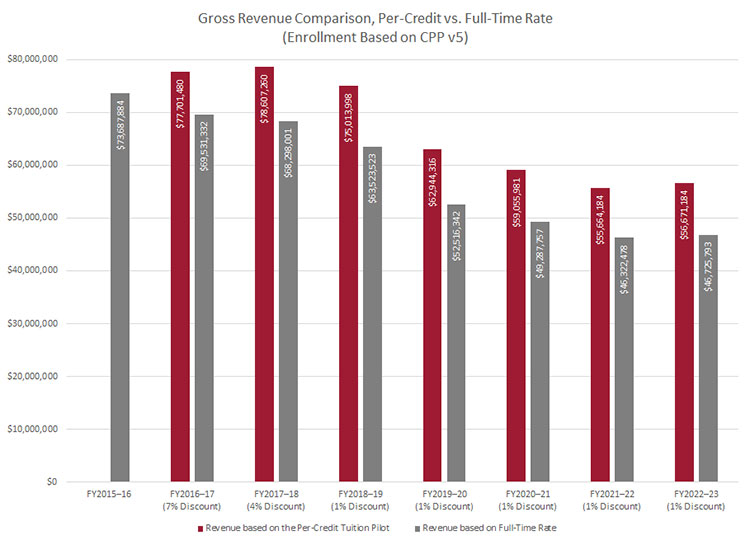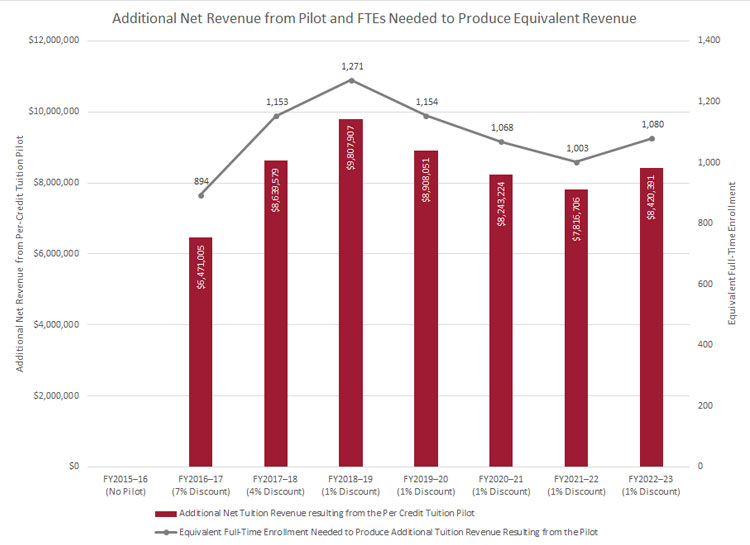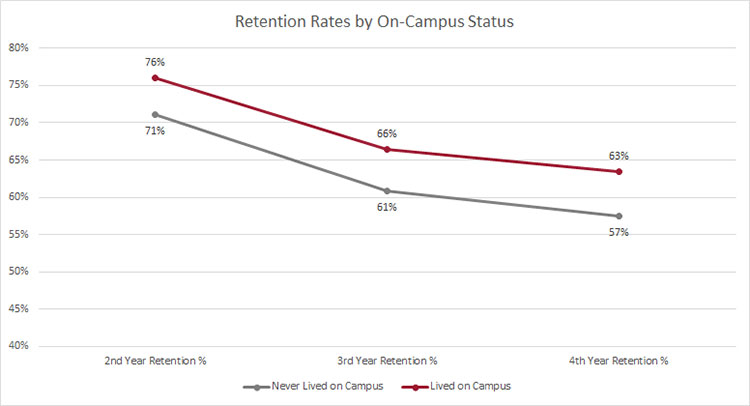As we focus on becoming the truly student-centered university we aspire to be, we are all rightly concerned about reducing the cost of attendance for our students.
Some have been asking how certain past decisions may contribute to that cost. While our work must remain forward focused, it’s important to understand those decisions and their current status.
I’d like to talk with you today about two important initiatives, the Residential Revival and the per-credit tuition model. Aspects of these initiatives are financially complex. I’ll give a high-level overview here, and you can find and download more information on this web page. If you have additional questions, please ask.
Residential Revival
IUP’s Residential Revival, the $245-million project to replace 11 of IUP’s traditional residence halls with eight suite-style, living-learning facilities, was completed in 2010. In addition to providing housing for students, these buildings each house some type of campus amenity in their ground-floor spaces.
This is a public-private partnership; the Foundation for IUP owns the buildings, and IUP manages the buildings, which were developed in four phases. More on the financing of this project in a few minutes.
Please bear with me as I review some history.
Discussions about “what should we do about housing” began in 2004, when most of IUP’s dormitories—and I use that word deliberately—were 35 years old or older. Cement-block structures with no air conditioning and very few common spaces for students to work together. Long corridors of rooms with group bathrooms. Potential students chose not to attend IUP when they saw where they would be living.
A story in the Chronicle of Higher Education in April 2008, “ Swanky Suites, More Students? ” pulled no punches about the state of dormitories and what IUP staff members experienced with prospective students and families: “Students would be accepted here, visit the campus, take one look at the outdated dormitories, and decide to go someplace else.”
The extensive planning and discussion process involved students, faculty, and other members of the IUP and Indiana communities from 2004 to 2006. The process included a University Planning Council recommendation that programs for first-year students be enhanced to improve the quality of their campus and community experiences and to improve retention and success. These facilities would put student needs first, and they would integrate living and learning spaces within the facilities to enhance academic success.
The IUP Council of Trustees approved the plan at its December 2004 meeting, forwarding the recommendation to the State System Board of Governors, which approved the plan at its January 2005 meeting. Building began in spring 2006.
At the end of construction in 2010, there were 3,528 beds available in the eight new buildings.
Multiple years of data show that first-year students who live on campus typically return for their second year at a higher percentage rate than first-year students who live off campus. In fall 2017, for example, retention of students who lived on campus was 70.96 percent, compared to 66.54 percent for students who never lived on campus.
Overall, students living in our residence halls show higher grade point averages than students who live off campus—especially upper-class students.
| On Campus Only | Off Campus Only | |||
|---|---|---|---|---|
| Class Standing | Overall GPA | Semester GPA | Overall GPA | Semester GPA |
| First-Year | 2.71 | 2.69 | 2.61 | 2.47 |
| Sophomore | 3.11 | 2.92 | 2.94 | 2.78 |
In these COVID-19 times, because of suite-style living, we were able to pivot very quickly and offer housing with individual bedrooms and bathrooms, or two-person shared bedrooms and bathrooms, that met Centers for Disease Control health and safety guidelines. The old dormitory setup with a shared bathroom would have made housing impossible for our students under current health and safety guidelines.
Not surprisingly, it costs more to provide suite-style living to our students than to provide dormitories. In fact, for a typical student living on campus, housing is about a third of the total bill. If you add the cost of a meal plan, room and board is about 48 percent of the total.
That’s true even though prices for living in these suites have been frozen since fall 2016 and meal plans have been frozen for the last two years. We are grateful that our partners in the Foundation for IUP have held the line on housing costs and that our Aramark partners have kept costs down. We expect that both housing costs and meal plan pricing will hold steady for 2021–22. We also anticipate introducing additional meal plans in a variety of price ranges to provide more options for students.
The numbers bear out market-study predictions that students would choose suite-style living created during the Residential Revival. Record enrollments followed the investment in the Residential Revival. IUP’s peak enrollment was its fall 2012 enrollment of 15,379 students; the Residential Revival was completed in fall 2010. University leadership in 2004 recognized that the Residential Revival would give IUP a competitive edge in recruitment and retention, and that remains true today.
The Residential Revival suites ranged from 97 percent to 90 percent occupancy in the first seven years, from 3,462 students in 2012–13 (our highest head count enrollment) and holding steady through 2017–18, when we housed 3,240 students.
Some comparison points:
- While enrollment dropped from fall 2012 to fall 2019 by 33 percent, occupancy in the suites dropped by 1,098 students, or 31 percent.
- While enrollment dropped from fall 2012 to fall 2018 by 25 percent, occupancy in the suites dropped by 690 students, or 19 percent.
- While enrollment dropped from fall 2012 to fall 2017 by 19 percent, occupancy in the suites dropped by much less—222 students, a 6.4 percent decrease.

We do not stand alone among our competitors in offering suite-style living, and we would be at a significant disadvantage without it.
Suite-style living continues to be the preferred style for our students: 85 percent of on-campus residents requested a single-bedroom, private bathroom suite or single-bedroom, two-person shared bathroom suite (the most expensive option). While price does not prevent the majority of students from choosing this option, we are working to reduce the cost of on-campus housing to our students.
Partnership with the Foundation for IUP
As I mentioned earlier, the Foundation for IUP retains ownership of the buildings and continues to manage the financing. The decline in occupancy has made it challenging for the foundation to make debt payments, let alone reduce the cost to students.
Even in these challenging times, the Foundation for IUP has been an outstanding partner in this project, and we appreciate the foundation’s keeping rates flat for our students for the last five years while it has looked for ways to reduce the cost of the debt.
In fact, the foundation has already refinanced phase I (Delaney Hall and Putt Hall) and phase IV (Stephenson Hall) through USDA backing, which allowed a much lower interest rate.
Currently, the foundation is working to restructure the debt obligations it incurred to finance the construction of phases II and III of the Residential Revival (Suites on Maple East, Ruddock Hall, Northern Suites, Suites on Pratt, and Wallwork Hall).
The need to restructure the debt on phases II and III has been exacerbated in large part because of the effects of the global pandemic. Economic conditions facing higher education have deteriorated such that the current debt service requirements can no longer be met.
The debt to be restructured consists of municipal bonds issued in 2007 and 2015 with terms of 30 to 40 years. The Foundation for IUP has retained legal counsel to assist with the restructuring discussions.
This is a positive and proactive initiative; we and the foundation want to continue to keep Residential Revival housing affordable to students while meeting financial obligations. IUP is grateful to have incredible expertise in the members of the Foundation for IUP Board of Directors; they have been highly involved in this initiative and continue to be proactive, working with the university to look at ways to cut expenses without impacting the on-campus living experience.
Per-Credit Tuition Pricing
In fall 2016, IUP launched its per-credit tuition pilot for undergraduate students, one part of a three-pronged budget strategy meant to initiate long-term budget sustainability in the face of flat funding from the commonwealth. As I have shared with you in earlier messages, IUP and the other universities in the State System receive roughly 23 percent of their budgets from the state.
This per-credit program brings IUP in line with higher education institutions across the nation and several in the State System by charging tuition on a per-credit-hour basis. It also aligns with the per-credit tuition model in our graduate programs.
We launched this per-credit model to increase fairness to all of our students, to help reduce the number of empty seats in scheduled classes, and to help IUP be financially stable.
In the per-credit model, all students, both full- and part-time, pay for the credits that they take. In the flat-fee model, part-time students were actually subsidizing full-time students, and students taking 12 credits subsidized those taking 15 to 17.9 credits, making the per-credit model more equitable.
We also discounted the per-credit tuition charge from the State System’s base tuition rate—significantly as the program phased in (7 percent and 4 percent in the first two years of the program)—and continuing with a 1 percent discount from the State System base tuition rate since 2018–19.
This per-credit model also recognizes that student behaviors have changed, and we need to be responsive to students who want, or need, to attend part-time.
You heard from Vice President Patricia McCarthy during the March 8 Facts, Initiatives, and Results that students are taking fewer credit hours than in the past. In fall 2015, 6.9 percent of the undergraduate students were part-time students. In fall 2020, 10.59 percent of undergraduate students were part-time students.
It’s worth noting that a higher percentage of our students are taking part-time course loads, a trend that is visible across the State System, regardless of per-credit or flat-fee tuition model.

| University Name | Spring 2012 | Spring 2013 | Spring 2014 | Spring 2015 | Spring 2016 | Spring 2017 | Spring 2018 | Spring 2019 | Spring 2020 | Spring 2021 |
|---|---|---|---|---|---|---|---|---|---|---|
| Bloomsburg | 11% | 10% | 10% | 11% | 11% | 12% | 13% | 14% | 14% | 16% |
| California | 22% | 23% | 24% | 26% | 30% | 31% | 33% | 35% | 33% | 36% |
| Cheyney | 6% | 16% | 8% | 13% | 12% | 10% | 7% | 28% | 5% | 12% |
| Clarion | 26% | 27% | 27% | 27% | 30% | 29% | 30% | 32% | 32% | 32% |
| East Stroudsburg | 16% | 14% | 14% | 14% | 14% | 15% | 15% | 17% | 18% | 22% |
| Edinboro | 21% | 20% | 21% | 21% | 21% | 20% | 21% | 22% | 25% | 26% |
| Indiana | 15% | 15% | 16% | 16% | 17% | 18% | 19% | 20% | 23% | 25% |
| Kutztown | 12% | 11% | 11% | 11% | 12% | 12% | 13% | 14% | 16% | 18% |
| Lock Haven | 10% | 11% | 11% | 12% | 11% | 11% | 13% | 13% | 15% | 21% |
| Mansfield | 17% | 18% | 17% | 15% | 15% | 13% | 14% | 14% | 15% | 21% |
| Millersville | 18% | 19% | 20% | 21% | 23% | 25% | 27% | 28% | 28% | 33% |
| Shippensburg | 15% | 15% | 15% | 16% | 16% | 17% | 20% | 19% | 19% | 21% |
| Slippery Rock | 11% | 11% | 13% | 14% | 16% | 15% | 15% | 15% | 15% | 17% |
| West Chester | 19% | 18% | 18% | 19% | 20% | 21% | 21% | 21% | 22% | 23% |
The per-credit model has met our projections, resulting in increased revenue for the university of approximately $50 million since 2016–17, with an estimated additional tuition revenue of $9.3 million and $9.9 million projected for 2021–22 and 2022–23, respectively. This revenue has assisted and will assist IUP in off-setting revenue losses because of enrollment declines and will help us provide increased student financial support.


Downloadable Resources
“Swanky Suites, More Students?” Chronicle of Higher Education, April 11, 2008
Background Information on Housing at IUP
Revenue Comparison Analysis, Per Credit v. Flat Fee Tuition Models
This pricing model has helped with the university’s budget situation over the past five years, including preventing earlier rounds of layoffs and decreasing the number of current layoffs. However, equally important is that with the per-credit tuition model, we were able to return approximately $8 million in financial support to 8,260 qualified students over the past five years—more than $4.3 million through the Academic Success Initiative and more than $3.6 million from the need-based scholarship initiative.
To continue to provide assistance to our students, and in support of student success and affordability, the university has committed to allocating resources gained in the per-credit model in the form of student grants and scholarships of over $1.4 million in both the 2021–22 and 2022–23 academic years. These funds are part of the university’s overall plan to provide student grants and scholarships of close to $8.2 million in 2021–22 and more than $10.7 million in 2022–23.
To achieve the same revenue as projected for the current fiscal year if we were to move back to the flat-fee model, we would need to enroll an additional 1,266 in-state, full-time undergraduate students (students taking 12 credits or more). Students taking 12 credits would pay more, and it is very unlikely that IUP would see such a large increase in enrollment for the reduction in price for students taking 13–18 credits.
We can continue to debate the merits or consequences of the decisions of the past, as I am certain we will do with the decisions we make today. That’s just the natural course of history. As did our predecessors, we will apply careful, rigorous analysis as we make our decisions for the future.
In the same way that our past decisions should not define our destiny, we cannot let our worries about future criticisms prevent us from taking action now, especially when this action is critical to moving IUP forward. We may not agree on all of the methods—and that is okay—because we agree on the goal: creating a sustainable and more student-centered university.
